Search results for "2010/02/let-us-eat-cake"
Shortlist for Finlandia Prize for Non-Fiction 2014
13 November 2014 | In the news
 The shortlist for the Finlandia Prize for Non-Fiction 2014 – worth €30,000 – was announced on 5 November by the chairperson of the jury, Susanna Pettersson, Director of the Ateneum Art Museum. The works on the list of six are as follows:
The shortlist for the Finlandia Prize for Non-Fiction 2014 – worth €30,000 – was announced on 5 November by the chairperson of the jury, Susanna Pettersson, Director of the Ateneum Art Museum. The works on the list of six are as follows:
Pohjolan leijona, Kustaa II Adolf ja Suomi 1611–1632 (‘The lion of the North. Gustavus II Adolphus and Finland 1611–1632’, Siltala) by the historian and author Mirkka Lappalainen deals with the implications of actions of the mighty Swedish king on the part of the kingdom that was known as Finland.
Herkkä, hellä, hehkuvainen – Minna Canth (‘Sensitive, gentle, radiant – Minna Canth’, Otava) is a fresh biography of the Finnish pre-feminist author (1844–1897), a popularised version of a dissertation by Minna Maijala.
Karanteeni. Kuinka aids saapui Suomeen (‘Quarantine. How Aids came to Finland’, Siltala) by Hanna Nikkanen & Antti Järvi records the history of the disease, its arrival and consequences in Finland.
Operaatio Elop (‘Operation Elop’, Teos) by Pekka Nykänen & Merina Salminen is the story of the mobile phone company Nokia in its declining years and its Canadian CEO (2010–2013) Stephen Elop, who did not become the saviour of the company on the global market.
Usko, toivo ja raskaus. Vanhoillislestadiolaista perhe-elämää (‘Faith, hope and pregnancy’, Atena) by Aila Ruoho &Vuokko Ilola focuses on the family life, particularly the status of the woman, of a fundamentalist religious community in Finland.
Tulisaarna. Einojuhani Rautavaaran elämä ja teokset (‘Fiery sermon. Life and works of Einojuhani Rautavaara’, Teos) by Samuli Tiikkaja (journalist, music critic and researcher) is a biography of the composer Einojuhani Rautavaara (born 1928).
The winner – according to the rules of the prize, it will be given to a deserving Finnish generalist non-fiction book – will be chosen by Heikki Hellman, journalist and Dean ofthe School of Communication, Media and Theatre in Tampere, on 19 November.
Good school, bad pupils, or vice versa?
21 December 2012 | This 'n' that

Number one: Finland. The Pearson analysis, 2012
Finland is used to feeling pretty good about itself when it comes to education. In the widely respected PISA tests – the Organisation for Economic Co-operation and Development’s exams in science and literacy – Finnish schoolchildren have, since the turn of the century, been outperforming most of their peers.
A shock came in 2009 when the tests revealed that Finnish kids were only third-best at reading, and sixth in maths; but by this time they were competing against the newly participating Asian countries, with their huge concentration on education.
Now, however, a new league table, drawn up by the education publishers Pearson, places Finland right at the top (2006–2010, 40 countries). Second place is held by South Korea; third is Hong Kong. The Pearson analysis uses a broader set of criteria, using not just test results but broader measures such as how many people go to university. In a result that is causing some puzzlement in the United Kingdom, Britain is rated sixth. Entirely, say critics, because British universities are so easy to get into.
The results are indeed flattering to Finland – but Finnish children’s motivation to learn is among the weakest in the survey’s countries. In reading, mathematics and the sciences Finns’ attitudes and application were low. It looks as if Finnish children consider school a place to hang out with their friends, not a place for teaching and learning. Countries where competition is stronger breed different attitudes.
So here’s the Finnish paradox: kids here hate school – yet still end up at the top of the list.
Must be something in the water.
Kvinnornas Helsingfors: en kulturhistorisk guide [Women’s Helsinki: a culture-historical guidebook]
6 May 2011 | Mini reviews, Reviews
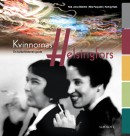 Kvinnornas Helsingfors: en kulturhistorisk guide
Kvinnornas Helsingfors: en kulturhistorisk guide
[Women’s Helsinki: a cultural-historical guidebook]
Red. [Ed. by] Anna Biström, Rita Paqvalén, Hedvig Rask
Helsingfors: Schildts, 2010. 251 p., ill.
ISBN 978-951-50-2007-9
Finnish-language edition: Naisten Helsinki: kulttuurihistoriallinen opas
ISBN 978-951-50-1994-3
€ 34, paperback
A group comprising fourteen women has addressed the question of what the map of Helsinki would look like seen through women’s history: what are the most significant places and monuments; what traces of women’s history could one read in the fabric of the city? This book portrays various eras in the city’s history from the 16th century onwards, along with profiles of female pioneers in fields from architecture to parliamentarians, from early political activists to present-day squatters. Helsinki has often been called ‘the city of women’ due to the large influx of women who came to work in the Finnish capital, particularly in the early 20th century – the increase in the number of office girls even boosted the publishing and film industries. In his Finnish letters written in the 1890s, Spanish author and diplomat Ángel Ganivet expressed his horror at the bicycling women of Helsinki. This book also includes pieces written by prominent contemporary women, from Finnish President Tarja Halonen to author Pirkko Saisio.
Translated by Ruth Urbom
Irma-Riitta Järvinen: Kalevala Guide
10 September 2010 | Mini reviews, Reviews
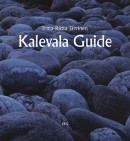 Kalevala Guide
Kalevala Guide
Helsinki: Finnish Literature Society, 2010. 127 p., ill.
ISBN 978-952-222-193-3
€ 24.90, paperback
This book is a brief but comprehensive English-language guide to the Finnish national epic, which was based on the archaic oral, sung folk poetry of Karelia, but collected and personally compiled by the scholar and writer Elias Lönnrot (1802–1884). The epic (first edition 1839, complemented in 1849) is set in a mythic past; technically speaking, the metre is an unrhymed, non-strophic trochaic tetrametre, characterised by alliteration. Contents, characters, places and themes are explained in the Guide, which also explores myths of origin and the significance of the epic. On his eleven trips to Archangel and North Karelia, Lönnrot met some 70 singers. The Kalevala, now translated, at least in part, into more than 60 languages, has inspired artists the world over (J.R.R. Tolkien was a fan, while Henry Wadsworth Longfellow’s Hiawatha imitates the metre and style of the Kalevala). The composer Jean Sibelius and the artist Akseli Gallen-Kallela are perhaps the best known Finnish Kalevala artists. And the inspiration continues: for instance, rock musicians and visual artists make use of Kalevala themes, stories and characters in their work. The book includes a list of relevant websites and a select bibliography.
Maria Turtschaninoff: Underfors [Underville]
28 January 2011 | Mini reviews, Reviews
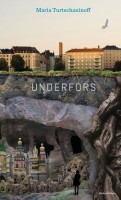 Underfors
Underfors
[Underville]
Helsingfors: Söderströms, 2010. 342 p.
ISBN 978-951-52-2739-3
€16 , hardback
This highly original fantasy novel by the Swedish-speaking author Maria Turtschaninoff (born 1977) is evidence of the innovative thinking that Finnish authors for young people bring to the international fantasy genre, particularly the currently fashionable vampire and werewolf themes associated with the borderline between life and death. The protagonist, Alva, is an adopted teenage girl who has some black holes in her memory of early childhood. A young man called Nide leads Alva to a land situated beneath Helsinki, where Alva learns that she is the heir to the shadow king. This novel is teeming with goblins, sprites, kelpies, pixies and sorceresses. Events come to a head on Midsummer Night, when magic spells can come true. Underfors is a classic story of a person’s search for her identity: Alva constructs her shattered self using fragments she finds from her past. She is liberated from guilt, longing and her inexplicable anguish, but becoming free requires sacrifices and struggles with ethical issues.
Translated by Ruth Urbom
Sodan kasvattamat [Brought up by war]
6 May 2011 | Mini reviews, Reviews
 Sodan kasvattamat
Sodan kasvattamat
[Brought up by war]
Toimittaneet [Ed. by]: Sari Näre, Jenni Kirves and Juha Siltala
Helsinki: WSOY, 2010. 464 p., ill.
ISBN 978-951-0-36733-9
€ 34, hardback
This volume is a collection of personal historical accounts relating to child-rearing and youth during the Finnish Winter and Continuation Wars (1939–1944). In the war years, 60,000 children were orphaned and nearly 80,000 were evacuated abroad, mainly to Sweden; in relative terms, this was a greater proportion of the nation’s children than were similarly affected anywhere else in the world. Some 150,000 children lost their homes in bombing raids or in the Finnish evacuation from the region of Karelia. Finland’s agrarian society taught these children to be obedient and to get by without assistance from adults. The Finnish civil war of 1918 had its effects as well: people did not talk much about their emotions. In circumstances where disciplined sacrifice was emphasised, young people found solace in games, sport and working. Researcher Ville Kivimäki speculates that the widespread experience of an unprotected childhood may have led, at least in part, to Finland’s establishing a social welfare state after the Second World War, as a kind of compensation. The material draws on earlier research, archived personal accounts and memoirs as well as numerous new in-depth interviews.
Translated by Ruth Urbom
Inside and out
14 February 2011 | Reviews

Markku Pääskynen. Photo: Ville Palonen
It is typical of Markku Pääskynen’s fiction for horrible things to happen both in people’s internal worlds and what goes by the name of the objective reality around them, and you can’t always be sure which one they’re happening in – or they’re happening in both.
From his debut novel, Etanat (‘Snails’, 2002, Tammi), onwards Markku Pääskynen (born 1973) has created a highly original body of work. His special strengths are his linguistic and narrative virtuosity, which allow him to make surprising events and narrative solutions come off in a controlled manner.
Pääskynen’s third novel, Tämän maailman tärkeimmät asiat (‘The most important things of this world’, 2005, featured in Books from Finland 1/2006), was a description of a single day that focused on the relationship between an adult son and his mother. Pääskynen’s sixth book, Enkelten kirja (‘Book of Angels’, 2010), is constructed out of sensory perceptions, thoughts, feelings and memories. The reader has to stay on his toes in piecing together the course of events, gradually revealed from behind these elements, and to find the story behind the plot. More…
Heikki Hiilamo: Kuoleman listat. Suomalaisten salainen apu Chilen vainotuille [Death lists. Secret assistance of the Finns to Chilean dissidents]
17 September 2010 | Mini reviews, Reviews
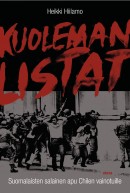 Kuoleman listat. Suomalaisten salainen apu Chilen vainotuille
Kuoleman listat. Suomalaisten salainen apu Chilen vainotuille
[Death lists. Secret assistance by Finns to Chilean dissidents]
Helsinki: Otava, 2010. 362 p., ill.
ISBN 978-951-1-24003-7
€ 32, hardback
The 1973 Chilean coup that ousted President Salvador Allende, and the subsequent persecution of dissidents, forced Allende’s supporters to seek asylum in foreign embassies. A number of refugees climbed over the wall of the Santiago home of Finland’s chargé d’affaires, Tapani Brotherus. As the Finnish official line of neutrality was to avoid interfering in the internal affairs of other countries, Brotherus was taking a great personal risk, by allowing this, and keeping it secret from the Finnish Ministry of Foreign Affairs. With the help of the embassy’s undersecretary and the East German diplomat Arnold Voigt, he and his wife succeeded in helping some 2, 200 people to leave Chile. Brotherus also helped 182 political refugees to obtain asylum in Finland. Heikki Hiilamo, who is now Research Professor at Kela, the Social Insurance Institution of Finland, describes the background of the Chilean dictatorship and the development of the broad-based solidarity movement, which has been characterised as one of the central formative experiences of the generation that grew up in 1970s Finland. The movement’s activists included future Finnish presidents Mauno Koivisto and Tarja Halonen, as well as the future Nokia CEO Jorma Ollila.
Anja Snellman: Parvekejumalat [Balcony gods]
30 September 2010 | Mini reviews, Reviews
 Parvekejumalat
Parvekejumalat
[Balcony gods]
Helsinki: Otava, 2010. 316 p.
ISBN 978-951-1-22756-4
€ 31.80, hardback
The theme of this novel is delicate and still largely silenced: the collision between the cultures of Muslim immigrants and the local population. Immigration into historically homogeneous Finland is a comparatively newer phenomenon than in many other European countries. Like other teenage girls, the Somali girl Anis dreams about partying, boys and a future, which completely deviaties from the customs and ideals of her patriarchal Muslim family. Her counterpart, the Finnish girl Alla, wishes to convert to Islam, because she has found herself suffering at home from the consequences of Western ‘freedom’ and is left with a feeling of devastating insecurity. Islamic culture’s halal and haram (strictly ‘good’ and ‘bad’) crushes or is crushed in Finnish life. The provocative contrasts and solutions presented in Snellman’s novel (her 19th) appear occasionally overemphasised. In defending the right of women to determine their own lives, Snellman (born 1954) deals Anis an extraordinarily tragic fate.
The naked truth
18 January 2011 | This 'n' that
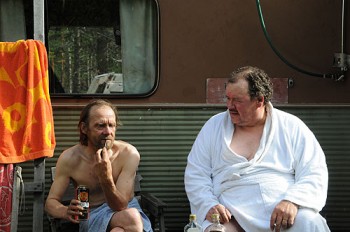
Out with the truth: sauna camaraderie in the film Steam of Life. Photo: Oktober
Finnish men don’t usually open up about much, it’s generally thought, as they don’t like to speak about feelings.
But in the sauna, it’s different. Intimacies are revealed in its soft steam, by men who sit there quietly and give voice to the sorrows of their lives.
In Miesten vuoro / Steam of Life, a full-length documentary film by two directors, Joonas Berghäll and Mika Hotakainen which premiered in March 2010, Finnish men both talk and weep. They have gained considerable popularity among audiences in Finland and abroad.
A naked guy sits on a wooden bench in the steam or outside the sauna building (which could be an old wooden hut in the countryside, a modern city sauna or some odd construction serving the purpose) with a bottle of beer in his hand, and tells the man sitting next to him in earnest about his dead child, new wife, or the death of his mother: the great sorrows or joys of his life.
Water, fire, bare skin and no ornaments: vulnerability. He can be a war veteran or a younger man, lonely or happily married. But he talks, cleansing himself both physically and mentally.
Steam of Life has so far been seen by approximately 50,000 people in Finland, and the DVD has sold more than 28,000 copies. It is the first Finnish documentary to compete for the Academy Award for Best Foreign Language Film. The Oscar nominees will be published on 25 January, with the award ceremony taking place at the end of February.
Steam of Life has won prizes both in Finland and abroad: in Tel Aviv, Warsaw, Pärnu in Estonia, Germany (DOK Leipzig where it won a Silver Dove) and Portugal. It received a Special Jury Mention at the Silverdocs documentary film festival in the United Sates and the Prize of the Interreligious Jury at the Visions du Réel festival in Switzerland. It will continue its tour of film festivals this year; see the trailer here.
The DOK Leipzig jury commented: ‘The film, deliberately set in an original Finnish situation – a sauna, opens a door into the intimate and hidden world of men’s fragility and vulnerability, turning the sauna into a place where naked truth is told by naked men. The film bends together tragic and comic….’
Mies ei puhu eikä pussaa is a saying; we’d translate this as ‘a Finn neither speaks nor snogs’, Finn referring to a male person. But the times, they are a-changing, it seems.
Cool, not ice-cool
17 October 2013 | This 'n' that
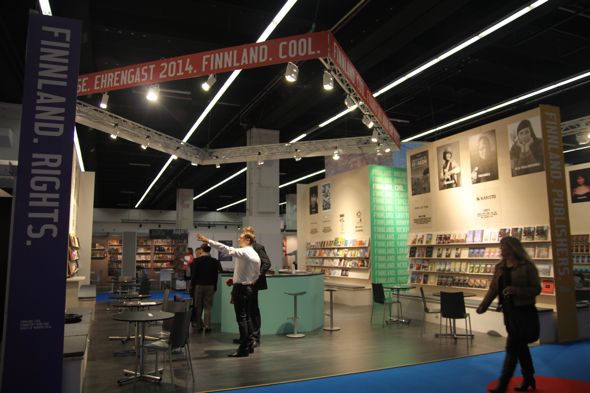
Getting ready: book fair scenery, 2013. Photo: FILI
The Finnish book world is preparing for the big event of ‘F14’: Finland will appear as Guest of Honour at the Frankfurt Book Fair in October next year.
The slogan for this enterprise is Finnland. Cool.
The coordinating organ is FILI, the Finnish Literature Exchange, a part of the Finnish Literature Society. Co-operating with FILI are three ministries, literary organisations and publishers, the Finnish Embassy and Finnland-Institut in Berlin and the Goethe-Institut in Helsinki.
Last week a large proportion of the FILI staff – who now need to keep their cool for the next busy year – went to Frankfurt, and on 10 October (aptly, the memorial day of the national author Aleksis Kivi and also Finnish Literature Day) the press conference was opened by the Finnish Minister of Culture and Sport, Paavo Arhinmäki. On 13 October the 2013 Guest of Honour, Brazil, passed the baton to Finland. (More photographs here.)
The world’s largest book fair, Frankfurt, attracts some 300,000 visitors each year. Accessible to both professionals and the general public, the fair is also the biggest cultural event in Germany.
The Guest of Honour countries receive a vast amount of attention in the media, and the number of new translations from the respective languages into German, as well as other languages, will increase.
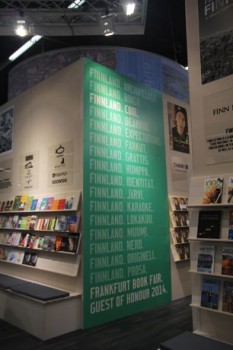
Finnland: arktik. Blondi. Cool. Demokratia. Einsam. Formula 1. Girji. Heimat. Ihminen. Joy…. Photo: FILI
The total Finnish budget for the years 2010–2015 is approximately four million euros, half of it money from the government. And the mission? Here are some warm words from the cool FILI agenda:
‘Why are Finns reading so much? Why are Finns so good at reading? Because we love it. Because reading plays such an important role in everyday life.
‘And because it is so important in Finland that everybody has access to reading – regardless of whether you are male or female, where you live, where you work, what your education or talent is. Fun, everyday life and for everyone – these are the main themes of the satellite programme for the Guest of Honour at the Frankfurt Book Fair 2014.’
What Finland read in April…
18 May 2012 | In the news
…was Tuomas Kyrö mostly, it seems: at the top of the April list of best-selling fiction titles in Finland, compiled by the Finnish Booksellers’ Association, was his novel Mielensäpahoittaja ja ruskeakastike (‘Taking offense: the brown sauce’, WSOY).
In March, Kyrö (born 1974) already featured twice on the list: his first novel about a 80-something man, Mielensäpahoittaja (‘Taking offense’, WSOY, 2010) was number two, and the newly-published sequel, Mielensäpahoittaja ja ruskeakastike had shot up to sixth place. In April they changed places – with the audio book version of the brown sauce book at number five.
This mielensäpahoittaja, ‘he who takes offence’, lives in the countryside and opposes most of what a contemporary lifestyle has to offer. Finns are evidently highly amused by the opinions of this obstinate, grumpy old man. But the popularity of Kyrö’s literary creation may also be boosted by the fact that he currently takes part in a television talk show every week, entertaining the audience and his fellow guests with his often acerbic remarks.
A crime novel by Seppo Jokinen, Hervantalainen (‘The person from Hervanta’, Crime Time), occupied third place, Tarhapäivä (‘Kindergarten day’, Otava) by Eve Hietamies fourth.
On the non-fiction list Solzhenitsyn’s The Gulag Archipelago, republished by Silberfeldt in April, was already in third place; we published a news piece about it on 25 April.
 The non-fiction list was topped by a new, controversial book by banker – and one of the richest men in Finland – Björn Wahlroos, Markkinat ja demokratia. Loppu enemmistön tyrannialle (‘Market and democracy. The end of the tyranny of the majority’, Otava). He favours the methods of Margaret Thatcher’s economic policy and opposes social benefits for the poor; according to him, the market economy is superior to democracy any time.
The non-fiction list was topped by a new, controversial book by banker – and one of the richest men in Finland – Björn Wahlroos, Markkinat ja demokratia. Loppu enemmistön tyrannialle (‘Market and democracy. The end of the tyranny of the majority’, Otava). He favours the methods of Margaret Thatcher’s economic policy and opposes social benefits for the poor; according to him, the market economy is superior to democracy any time.
Praise and prize for theatre on the edge of Europe
29 April 2011 | In the news
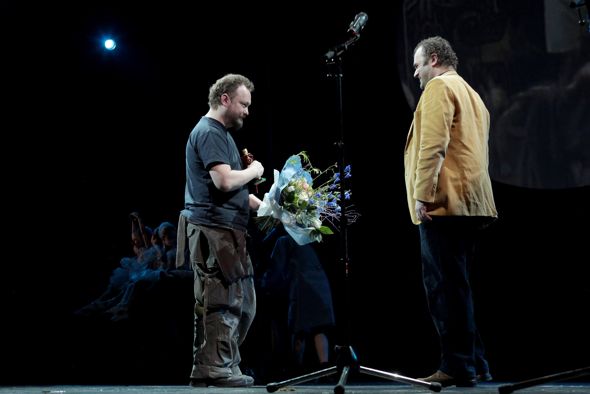
Kristian Smeds is awarded the XII Europe Prize of New Theatrical Realities in St Petersburg on 17 April, presented by a previous prize-winner, Italian theatremaker Pippo Delbono. Photo: rossetti/phocusagency
Theatremaker Kristian Smeds (born 1970) was awarded the XII Europe Theatre Prize for New Theatrical Realities in St Petersburg on 17 April. The prize, worth 30,000 euros, was – this time – divided between six prominent theatremakers or theatre groups. (For more information, see the Premio Europa website.)
The international prize jury consists of representatives of many institutions of the field. Since 1986 the main prize, the Europe Theatre Prize (worth 60,000 euros), has been awarded to 14 European theatremakers considered influential – among them, the directors and/or writers Ariane Mnouchkine, Peter Brook, Heiner Müller, Lev Dodin, Harold Pinter, and now, the German director Peter Stein. More…
Government prize for translation 2012
14 September 2012 | In the news

Vladimír Piskoř. Photo: Charlotta Boucht
The Finnish Government Prize for the Translation of Finnish Literature of 2012 – worth €15,000 – was awarded to the Czech translator Vladimír Piskoř.
Piskoř (born 1960), graduated from the Charles University of Prague in 1984, majoring in Finnish. Since the early 1990s he has translated almost 30 titles, most by contemporary authors, including Kristina Carlson, Kari Hotakainen, Leena Krohn, Rosa Liksom, Asko Sahlberg, Juha Seppälä, Petri Tamminen and Maria Peura.
‘I personally am fond of the novels by Kari Hotakainen: I sometimes play with the idea of becoming a writer myself, and I find his style and themes particularly interesting. Kristina Carlson’s latest novel Herra Darwinin puutarhuri (‘Mr Darwin’s gardener’, 2010) is a truly inspiring work both as a reader and a translator,’ he says.
Piskoř is currently working on Kari Hotakainen’s novel Jumalan sana (‘The word of God’) and Leena Lander’s historical novel Käsky (‘Command’). In 2006 he was awarded the Czech translators’ special prize for the novel Höyhen (‘Feather’) by Asko Sahlberg.
Vladimír Piskoř received his award in Helsinki on 10 September from State Secretary Jarmo Lindén; he thanked Piskoř for the work he has done for the last twenty years, particularly in the field of contemporary Finnish fiction.
The prize has been awarded – now for the 38th time – by the Ministry of Education and Culture since 1975 on the basis of a recommendation by FILI – Finnish Literature Exchange.
Finland(ia) of the present day
2 December 2010 | In the news
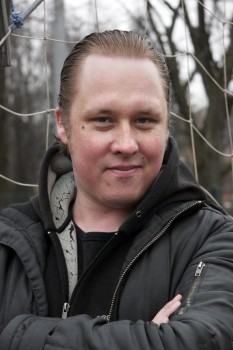
Mikko Rimminen. Photo: Heini Lehväslaiho
The Finlandia Prize for Fiction 2010, worth €30,000, was awarded on 2 December to Mikko Rimminen (born 1975) ; his novel Nenäpäivä (‘Nose day’, Teos) was selected by the cultural journalist and editor Minna Joenniemi from a shortlist of six.
Appointed by the Finnish Book Foundation, the prize jury (Marianne Bargum, former publishing director of Söderströms, researcher and writer Lari Kotilainen and communications consultant Kirsi Piha) shortlisted the following novels:
Joel Haahtela: Katoamispiste (‘Vanishing point’, Otava), Markus Nummi: Karkkipäivä (‘Candy day’, Otava), Riikka Pulkkinen: Totta (‘True’, Teos), Mikko Rimminen: Nenäpäivä (‘Nose day’, Teos), Alexandra Salmela: 27 eli kuolema tekee taiteilijan (’27 or death makes an artist’, Teos) and Erik Wahlström: Flugtämjaren (in Finnish translation, Kärpäsenkesyttäjä, ‘The fly tamer’, Schildts). Here’s the FILI – Finnish Literature Exchange link to the jury’s comments.
Joenniemi noted the shortlisted books all involve problems experienced by people of different ages. How to be a consenting adult? How do adults listen to children? Contemporary society has been pushing the age limits of ‘youth’ upwards so that, for example, what used to be known as middle age now feels quite young. And, for example, in Erik Wahlström’s Flugtämjaren (now also on the shortlist for the Nordic Literature Prize 2011) the aged, paralysed 19th-century author J.L. Runeberg appears full of hatred: being revered as Finland’s national poet didn’t make him particularly noble-minded.
According to Joenniemi, Rimminen’s novel ‘takes a stand gently’ in its portrayal of contemporary life – in a city where a lonely person’s longing for human contacts takes on tragicomical proportions. Joenniemi finds Rimminen’s language ‘uniquely overflowing’. Its humour poses itself against the prevailing negative attitude, turning black into something lighter.
Rimminen has earlier published two collections of poems and two novels (Pussikaljaromaani, ‘Sixpack novel’, 2004, and Pölkky, ‘The log’, 2007) . Pussikaljaromaani has been translated into Dutch, German, Latvian, Russian and Swedish.
